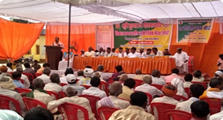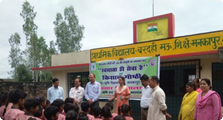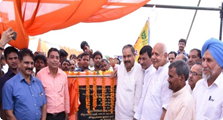District Profile
Gonda district is one of the districts of Uttar Pradesh, India. The city of Gonda is the district headquarters, and also the administrative centre for the Devipatan Division.
With an area of 4,003 square kilometres , Gonda has borders with Shrawasti district to the north, Balrampur and Siddharthnagar districts to the northeast, Basti district to the east, Faizabad district to the south, Bara Banki district to the southwest, and Bahraich district to the northwest. The district lies between 26° 47′ and 27° 20′ north latitude and 81° 30′ and 82° 46′ east longitude.
a) General Characteristics of the District : Gonda is one of the districts of Uttar Pradesh; India. Gonda town is district headquarters and also the administrative centre for the Devipatan Division. It has 2 lok sabha seats and 7 assembly areas. Rivers have played a significant role in the development of Gonda. Ghaghara is the main river flowing through the district, formed from the united waters of the Kauriala, Saryu, and Chauka & other rivers which drain the submontane tract to the west. It enters the district in the extreme west and flows along the southern borders. Within its wide bed it rolls from one side to the other, changing its channel almost every year. The land along the river is always liable to be cut away during the rains and for this reason the area of the district is libel to annual verialims. Saryu is the second most important river, rising in the Bahraich district, and joining the Ghaghara in Gonda. The Kuwano River flows along the northern border, with the Bisuha, a small stream of a similar character. The Manwar, Chandai and Terhi rivers are little more than streams. There are several important lakes in the district, including the Banki, Kodar, Aranga, and Parwati & Pathri.
b) Location & Geographical Area : With a geographical area of 4003 sq. km, Gonda is bound by Shrawasti district to the north, Balrampur and Sidharthnagar district to the north east, Basti district to the east, Faizabad to the south, Barabanki to the south west and Bahraich to the northwest. The district lies between 26° 47' and 27° 20' north latitude and 81° 30' and 82° 46' east longitude Gonda has three seasons: Summer (Mar-Jun), rainy (Jul-Oct) and winter (Nov-Feb).The average summer temperature is nearly 34 °C. A hot wind named Loo 4 blows in May and in early June. During the rainy season, rains take place up to September. Average Rainfall in the district is 1152mm. 1.2 Topography: The holy rivers Saryu and Ghaghra pass through the district. The soils of the district are composed of the fluvial deposits of these two rivers. The entire district falling in sai sub basin of Ganga basin represents flat topography.
c) Availability of Minerals : This district is Poor in Avaibility of Minerals. Though few minor minerals like sand & Kankar are found, these are used to construct houses and buildings in Gonda. 1.3 FOREST: The district has 12120.09 hectares of total forest cover which is 3% of Total Area of District. Trees like teak, shesham, saal & etc are found. 1.4 Administrative set up Gonda is the district headquarters and administrative centre for the Devipatan division. It has 4 tehsils: gonda, mankapur, coloneganjand tarabganj. It has 16 blocks.
Major Farming Systems / Enterprises (based on the analysis made by the KVK)
| S. No. | Farming System/Enterprise |
|---|---|
| 1 | Crop Production + Livestock |
| 2 | Crop Production + Horticulture |
| 3 | Horticulture + Livestock |
Description of Agro-climatic Zone & major agro ecological situations (based on soil and topography)
| S. No. | Agro-climatic Zone | Characteristics |
|---|---|---|
| 1 | AES-I | Clay loam, Paddy, Sugarcane, Brinjal, Tomato, Okra, Mango & Fodder. |
| 2 | AES-II | Sandy Soil, Wheat, Gram, Groundnut, Paddy, Mustard, Potato, Maize, Arhar, Moong, Urad, Barley, Jowar, Lentil, Okra, Brinjal, Mango. |
| 3 | AES-III | Sandy Loam Rich in Organic Matter, Paddy, Maize, Arhar, Groundnut, Wheat, Pea, Sugarcane, Potato, Brinjal, Jackfruit, Mango. |
| 4 | AES-IV | Flood Prone, Sandy Soil, Paddy, Tobacco, Sugarcane, Wheat, Tomato, Muskmelon. |
Soil Type/s
| S. No. | Soil Type | Characteristics | Area in ha |
|---|---|---|---|
| 1 | Sandy Soil | Low Organic matter content high infiltration and percolation rate | 120884 |
| 2 | Sandy Loam | Fertile soil rich in soil nutrients | 197858 |
| Particulars | Name of Blocks | |
|---|---|---|
| Coverage | 1. Pandrikripal 2. Rupaideeh 3. Mujehana 4. Iteathok 5. Mankapur 6. Bhabhanjot 7. Chhapia 8. Katra |
|
| Soil Type | Sandy, Sandy loam & Loam soil | Clay, clay loam & silty clay ( plain and forest land) |
| Major Crops | Paddy, Wheat, Jowar, Pigeon pea, Chick pea, Field pea, Lentil, Mustard, Maize & Groundnut | Maize, Paddy, Wheat, Sugarcane, Lentil, Mustard, Toria |
| Live Stock | Buffalo, Cow, Goat, Sheep, Pig & Poultry | Buffalo, Cow, Goat, Sheep, Pig & Poultry |
| Fruit Plant | Mango, Guava, Lemon, Jackfruit, Papaya & Banana | Mango, Jackfruit, Papaya, Banana, Jamun, Bel |
| Vegetable & Spices Crop | Potato, Tomato, Brinjal, Chilli, Cole crop, Cucurbit, Coriander, Turmeric, Onion & Garlic | Potato, Tomato, Brinjal, Chilli, Cole crop, Cucurbit, Leafy vegetable Coriander, Methi, Funnel, Onion & Garlic |
| Major Forest Plant | Neem, Babul, Shisham, Teak, Eucalyptus | Eucalyptus, Babul, Sheesham, Teak |
Area, Production and Productivity of major crops cultivated in the district
| S. No. | Crop | Area (ha) | Production (MT.) | Productivity (Qt./ha) |
|---|---|---|---|---|
| 1 | Paddy | 129176 | 307697 | 23.82 |
| 2 | Wheat | 146855 | 462553 | 31.50 |
| 3 | Maize (kharif) | 45630 | 54300 | 11.90 |
| 4 | Chick Pea | 641 | 805 | 16.18 |
| 5 | Pigeon Pea | 5554 | 3600 | 6.48 |
| 6 | Lentil | 12341 | 114849 | 9.31 |
| 7 | Mustard | 10828 | 10845 | 10.28 |
| 8 | Pea (grain) | 3261 | 5276 | 16.18 |
| 9 | Til | 366 | 83 | 2.26 |
| 10 | Urd | 674 | 374 | 5.55 |
Source: Krishi Diary (ANDUA & T, Kumarganj, Ayodhya, 2020)
Production and productivity of livestock, Poultry, Fisheries etc. in the district
| Category | Population | Production | Productivity |
|---|---|---|---|
| Cattle | |||
| Crossbred | 3185 | 19110 lit. | 6.0 lit/day |
| Indigenous | 468449 | 936898 lit. | 2.0 lit/day |
| Buffalo | 296972 | 55024 lit. | 4 .0 lit/day |
| Sheep | |||
| Crossbred | 1910 | 573.00 kg. | 0.30 kg. |
| Indigenous | 11846 | 11.84 kg. | 1.00 kg |
| Goats | 438552 | 6578.78 lit. | 0.150 lit. |
| Pigs | 43458 | 13637.40 kg. | 0.30 kg. |
| Crossbred | 4710 | 1884 kg. | 0.40 kg. |
| Indigenous | 38748 | 8687 kg. | 0.25 kg. |
| Poultry | |||
| Hens | 208279 | 208279 kg. | 1.0 kg. |
| Ducks | 13152 | 1352 | 1.0 kg. |
| Fish | 744.23 | 161.00 q. | 0.216 |
*Statistical report
Details of operational area / villages (2019)
| S. No. | Taluk | Name of the Block | Name of the village | Major Crops & Enterprises | Major Problem Identified | Identified Thrust Areas |
|---|---|---|---|---|---|---|
| 1 | Manakapur | 1. Firozpur 2. Kolargoan |
Cereals: Wheat, Rice, Maize Pulses : Lentil and Pigeon pea Oil seeds : Toria Cash crop : Sugarcane |
|
Seed production : Wheat, Rice Cereals production : Rice, Wheat, Maize Income generation activities for rural women: Fruit and vegetable preservation |
|
| 2 | Rupaideeh | 1. Jamthara 2. Unchgaon |
Cereals : Wheat , Rice, Maize Pulses : Lentil and Pigeon Pea Oil seeds : Toria, Mustard Cash crop : Sugarcane |
|
Seed production : Rice, Wheat and Pulses Resource Conservation : Wheat IPM in Rice Rearing of goats, backyard poultry, leguminous fodder crops. Cultivation of cereals, pulses and Vegetables. |
| S. No. | |
|---|---|
| 1 |





